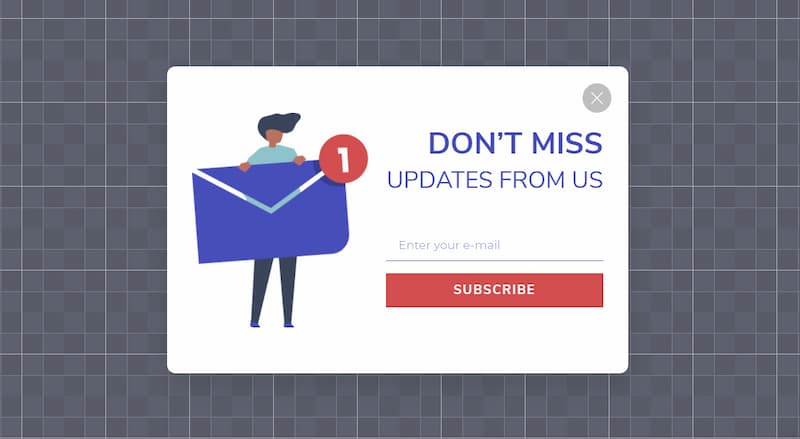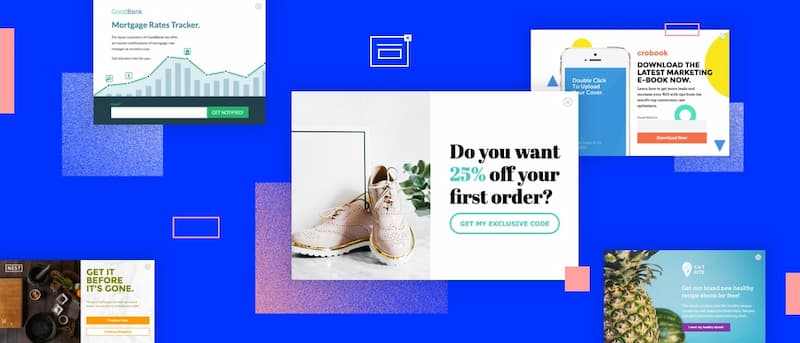What Are Pop-ups? Meaning & Types & Significance
Let’s start by defining pop-ups.
A pop-up is a brief window that appears as you browse a website. Pop-ups are primarily used by marketers for lead generation and advertising. With SendPulse, making a pop-up is simple and free.
Pop-ups are divisive; their creator even issued a formal apology for his work.
The user experience will be interrupted and your audience may become irritated if you use a window that appears out of nowhere. However, if a pop-up is brief and to the point, it might be a useful addition to your website that can help visitors and move them down the sales funnel.
Please continue reading as I will go into more detail about the specific information.
Table of Contents
What Are Pop-ups & What Purpose Do They Serve?
Pop-ups are windows that open while a user is browsing a website page and the content. They are set up in accordance with the strategy channel owner and may change based on visitor behavior.
Popups come in a variety of forms, and each one needs to be properly configured in order to accomplish its intended function. After all, they can bring many benefits for a company’s communication strategy, but when applied wrongly, they can disrupt the user’s navigation flow.
Overuse, for example, can reduce the quality of user experience with your page and, consequently, with the brand.
Pop-ups Types
Pop-ups generally fall into one of three categories: those that appear when clicking something on a web page, those that appear at random, and those that appear without user intervention, the most aggravating variation. The majority of the time, these busy windows only show advertisements for content the user doesn’t care about. There are times when the advertisements are extremely offensive or, worse yet, adult-oriented. It’s also possible for a pop-up to be a Trojan horse or other malicious program. These are traps that show security alerts in the form of warnings in an effort to get you to click the window and download unwanted content to your system.
Similar windows that aren’t pop-ups may also appear. In this case, the entire page shown in the browser window has no content and isn’t even a true page. In its place, a graphic that resembles a new pop-up window is present. In an effort to trick users into clicking on malicious content, this very confusing scheme is used. The fake pop-up and the page behind it are actually a part of a full-screen advertisement that contains a spyware trap. Due to their potential to develop into something much worse than an annoyance, these fake pop-ups should be handled with extreme caution.
Though it happens very infrequently, some trustworthy businesses may use what they describe as appealing or practical pop-ups on their website. The terms of licensing agreements and visitor response forms are displayed on them by some online businesses as marketing tools. These pop-ups have the same potential for annoyance even though they are not malicious.
Why Do Pop-ups Matter?
- Generate subscribers
- Promote specific content
- Reduce the bounce rate
Pop-ups are a versatile tool that can assist you in converting website visitors into marketing leads. The following is a list of the primary purposes of pop-ups:
- Generate subscribers. Consider the scenario where you have a large number of website visitors and have no idea how to engage them in communication with your brand. The solution is a pop-up subscription form where users can enter their email address. It enables you to expand your mailing list, establish email relationships with your audience, and quicken the purchasing process.
- Promote specific content. Although generating leads is the main goal of pop-ups, you can also use them to advertise your e-book, how-to guide, or case study that is pertinent to the page the visitor is on. By doing so, you’ll demonstrate your subject-matter expertise and assist your audience in finding solutions. On an agricultural blog, for instance, you could share your harvest forecasts for the following year.
- lower the bounce rate This metric displays the speed at which a user leaves your website. A pop-up that requests an email address, phone number, or other information in order to facilitate further communication is a common tactic used by marketers to lower bounce rates. When a user is about to close the tab or leave the website, a pop-up like this typically appears. See more about Can You Get Accurate Information From Social Media
Popup Or Pop-up?
In everyday speech, the word “popup” is commonly spelled “pop up,” “pop-up,” and “popup.”” Is it even possible that they all have the same meaning? Let’s see.
Pop up is a verb that describes the action of appearing suddenly.
Pop-up is used both as an adjective and a noun to refer to website popups.
Popup is the most popular spelling used to refer to a website popup, despite being grammatically incorrect.
The bottom line is, though, that people use all three versions to refer to website popup windows.

Pop-ups: Pros & Cons
A lot of websites use pop-ups without taking user experience (UX) into account, which gives them a bad reputation. Due to this, their reputation has been unfairly tarnished. But in actuality, when created and implemented with the user in mind, they can enhance the user experience.
The advantages and disadvantages of using website popups are listed below.
Pros:
- Generate leads
- Promote content
- Reduce cart abandonment
- Convert more website visitors
- Inform others about errors, alerts, etc.
- Share awareness of events, promos, and sales
- Drive traffic to landing and product pages
Cons:
- Reputation of being annoying
- Can be blocked with special software in browsers
The Best Pop-ups Features
The “best” marketing popups are those that add value to the user experience and are relevant to it. As a result, they frequently produce positive results and enhance the user experience.
They share some of these characteristics:
- Valuable. Businesses can use popups to their advantage by offering incentives like discounts, free access to content, or other benefits.
- SEO-friendly. They are guaranteed to have no impact on a website’s Google ranking due to their compatibility with SEO.
- Non-intrusive. To lessen intrusiveness and prioritize the UX, businesses can customize when and how frequently a visitor sees a popup.
- Visually consistent. They can be made to look like a logical extension of the website by using the color scheme and design of the website.
- Have engaging copy. Popup copy that is consistent with the brand personality engages website visitors in effective popups.
- Contain branded images. The viewer is drawn in by engaging, unique images that relate to the popup’s content.
Ways To Create A Pop-up Subscription Form
Let’s use these straightforward four steps to build a pop-up that addresses the most common goal—subscription—by following them.
Register With Sendpulse
A marketing platform called SendPulse offers a variety of ways to interact with customers and gives users all the resources they need to be successful. With SendPulse, you can build your mailing list, make beautiful pop-ups, and send bulk emails to that list. Register at no cost!
Choose A Pop-up Style Layout
You can create a new form by going to the “Subscription forms” tab in your account and selecting that option.” Four different layouts, including a pop-up template, are available, as shown in the screenshot below.
Customize The Form
Select the form’s size, add text, modify the button’s color and style, add a background image, etc. The layout of the user-friendly SendPulse subscription form builder is shown in the screenshot below.
To allow users to join your brand in Facebook Messenger and Telegram, you can also create a multichannel subscription form. You only need to add a link to a chatbot and drag the required Messenger icon. Look at the example form below.
Set Up Display Conditions
In the “Form options” section, specify the pages and circumstances on which your pop-up should appear. The choices are displayed in the screenshot down below.
In light of the fact that you now understand how to create a pop-up using SendPulse, review some best practices that will assist you in producing informative and useful pop-ups.
The Bottom Line
Pop-ups are versatile marketing tools that give businesses the ability to engage with website visitors, direct traffic to particular pages, collect email addresses, and accomplish a number of other objectives. A pop-up window on a website can enhance the user experience for visitors if it is created with best practices in mind.
Share this article if you liked it and let us know what you think in the comments section below!
